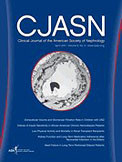Botev R, Mallié JP, Wetzels JF, Couchoud C, Schück O. Clinical Journal of American Society of Nephrology. 2011 Apr;6(4):937–50. Epub 2011 Mar 31. IF: 4,844

Abstract:
The GFR has a paramount diagnostic and staging role in the Kidney Disease Outcome Quality Initiative Clinical Practice Guidelines for Chronic Kidney Disease (K/DOQI-CKD). The most widely used serum creatinine-based formulas in adults for estimated GFR (eGFR) are the Cockcroft-Gault (CG) and Modification of Diet in Renal Disease Study (MDRD). Recently, a new Chronic Kidney Disease Epidemiology Collaboration equation has been developed. Review of the literature revealed that CG and MDRD formulas correctly assigned overall only 64% and 62%, respectively, of the subjects to their actual K/DOQI-CKD classification's GFR groups as determined by measured GFR (mGFR). This suggests that approximately 10 million (38 %) subjects may have been misclassified on the basis of estimated CKD prevalence of 26.3 million adults in the United States. The purpose of this review is to help the clinician understand the limitations of using eGFR in daily practice. We also elaborate upon issues such as the differences among markers of mGFR, the validity of adjusting GFR for body surface area in certain populations, the limited data on boundaries for normal mGFR according to age, gender, and race, the need for calibration of a wide spectrum of serum creatinine measurements, the lack of actual eGFR value above 60 ml/min per 1.73 m2 and reference for normal mGFR in the clinical laboratories' reports, and the performance evaluation of the eGFR formulas. Several pitfalls have to be overcome before we can reliably determine health and disease in daily nephrology practice to preserve the first rule of practicing medicine: primum non nocere.
-im-
